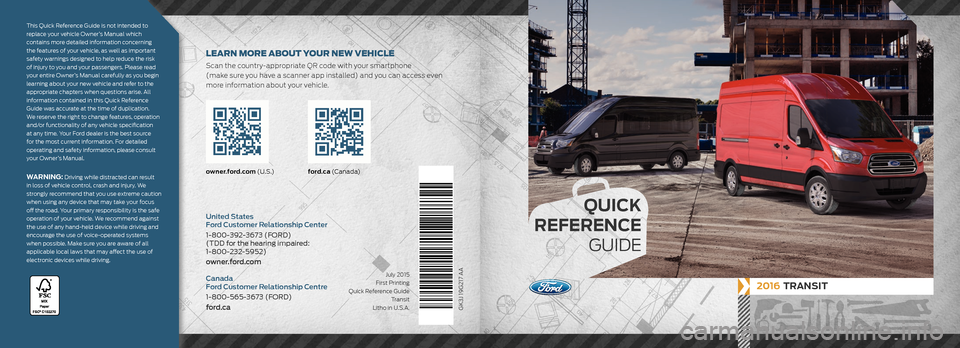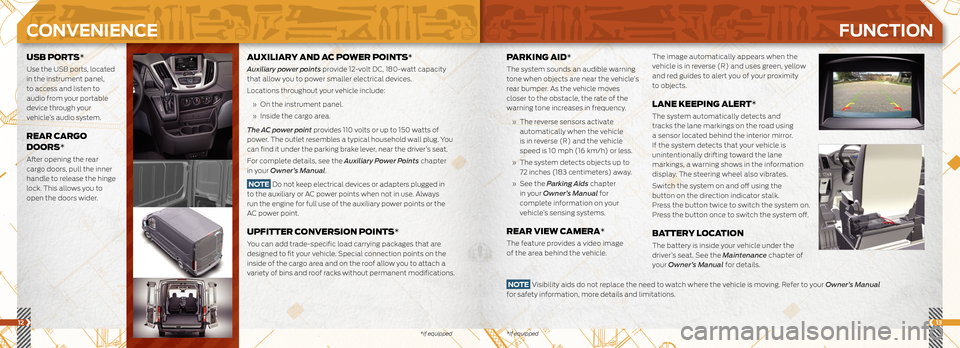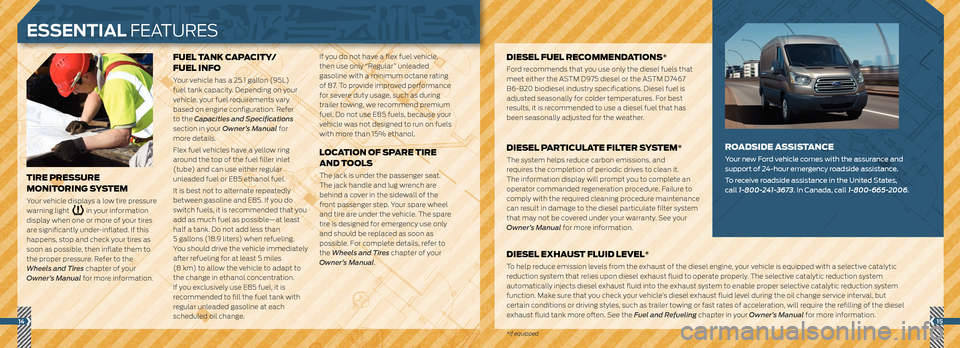warning FORD TRANSIT 2016 5.G Quick Reference Guide
[x] Cancel search | Manufacturer: FORD, Model Year: 2016, Model line: TRANSIT, Model: FORD TRANSIT 2016 5.GPages: 8, PDF Size: 11.99 MB
Page 1 of 8

2016 TRANSIT
GK3J 19G217 AA
owner.ford.com (U . S .) ford.ca (C a n a d a)
United States
Ford Customer Relationship Center
1-800-392-3673 (FORD)
(TDD for the hearing impaired:
1-800-232-5952)
owner.ford.com
Canada
Ford Customer Relationship Centre
1-800-565-3673 (FORD)
ford.ca
This Quick Reference Guide is not intended to
replace your vehicle Owner’s Manual which
contains more detailed information concerning
the features of your vehicle, as well as important
safety warnings designed to help reduce the risk
of injury to you and your passengers. Please read
your entire Owner’s Manual carefully as you begin
learning about your new vehicle and refer to the
appropriate chapters when questions arise. All
information contained in this Quick Reference
Guide was accurate at the time of duplication.
We reserve the right to change features, operation
and/or functionality of any vehicle specification
at any time. Your Ford dealer is the best source
for the most current information. For detailed
operating and safety information, please consult
your Owner’s Manual.
WARNING: Driving while distracted can result
in loss of vehicle control, crash and injury. We
strongly recommend that you use extreme caution
when using any device that may take your focus
off the road. Your primary responsibility is the safe
operation of your vehicle. We recommend against
the use of any hand-held device while driving and
encourage the use of voice-operated systems
when possible. Make sure you are aware of all
applicable local laws that may affect the use of
electronic devices while driving.
LEARN MORE ABOUT YOUR NEW VEHICLE
Scan the country-appropriate QR code with your smartphone
(make sure you have a scanner app installed) and you can access even
more information about your vehicle.
July 2015
First Printing
Quick Reference Guide Transit
Litho in U.S.A.
QUICK
REFERENCE
GUIDE
Page 7 of 8

1213
PARKING AID*
The system sounds an audible warning
tone when objects are near the vehicle’s
rear bumper. As the vehicle moves
closer to the obstacle, the rate of the
warning tone increases in frequency.
» The reverse sensors activate
automatically when the vehicle
is in reverse (R) and the vehicle
speed is 10 mph (16 km/h) or less.
» The system detects objects up to
72 inches (183 centimeters) away.
» See the Parking Aids chapter
in your Owner’s Manual for
complete information on your
vehicle’s sensing systems.
REAR VIEW CAMERA*
The feature provides a video image
of the area behind the vehicle. The image automatically appears when the
vehicle is in reverse (R) and uses green, yellow
and red guides to alert you of your proximity
to objects.
LANE KEEPING ALERT*
The system automatically detects and
tracks the lane markings on the road using
a sensor located behind the interior mirror.
If the system detects that your vehicle is
unintentionally drifting toward the lane
markings, a warning shows in the information
display. The steering wheel also vibrates.
Switch the system on and off using the
button on the direction indicator stalk.
Press the button twice to switch the system on.
Press the button once to switch the system off.
BATTERY LOCATION
The battery is inside your vehicle under the
driver’s seat. See the Maintenance chapter of
your Owner’s Manual for details.
AUXILIARY AND AC POWER POINTS*
Auxiliary power points
provide 12-volt DC, 180-watt capacity
that allow you to power smaller electrical devices.
Locations throughout your vehicle include:
» On the instrument panel.
» Inside the cargo area.
The AC power point provides 110 volts or up to 150 watts of
power. The outlet resembles a typical household wall plug. You
can find it under the parking brake lever, near the driver’s seat.
For complete details, see the Auxiliary Power Points chapter
in your Owner’s Manual.
NOTE Do not keep electrical devices or adapters plugged in
to the auxiliary or AC power points when not in use. Always
run the engine for full use of the auxiliary power points or the
AC power point.
UPFITTER CONVERSION POINTS*
You can add trade-specific load carrying packages that are
designed to fit your vehicle. Special connection points on the
inside of the cargo area and on the roof allow you to attach a
variety of bins and roof racks without permanent modifications.
USB PORTS*
Use the USB ports, located
in the instrument panel,
to access and listen to
audio from your portable
device through your
vehicle’s audio system.
REAR CARGO
DOORS*
After opening the rear
cargo doors, pull the inner
handle to release the hinge
lock. This allows you to
open the doors wider.
NOTE Visibility aids do not replace the need to watch where the vehicle is moving. Refer to your Owner’s Manual
for safety information, more details and limitations.
CONVENIENCE FUNCTION
*if equipped*if equipped
Page 8 of 8

1415
FUEL TANK CAPACITY/
FUEL INFO
Your vehicle has a 25.1 gallon (95L)
fuel tank capacity. Depending on your
vehicle, your fuel requirements vary
based on engine configuration. Refer
to the Capacities and Specifications
section in your Owner’s Manual for
more details.
Flex fuel vehicles have a yellow ring
around the top of the fuel filler inlet
(tube) and can use either regular
unleaded fuel or E85 ethanol fuel.
It is best not to alternate repeatedly
between gasoline and E85. If you do
switch fuels, it is recommended that you
add as much fuel as possible—at least
half a tank. Do not add less than
5 gallons (18.9 liters) when refueling.
You should drive the vehicle immediately
after refueling for at least 5 miles
(8 km) to allow the vehicle to adapt to
the change in ethanol concentration.
If you exclusively use E85 fuel, it is
recommended to fill the fuel tank with
regular unleaded gasoline at each
scheduled oil change. If you do not have a flex fuel vehicle,
then use only “Regular” unleaded
gasoline with a minimum octane rating
of 87. To provide improved performance
for severe duty usage, such as during
trailer towing, we recommend premium
fuel. Do not use E85 fuels, because your
vehicle was not designed to run on fuels
with more than 15% ethanol.
LOCATION OF SPARE TIRE
AND TOOLS
The jack is under the passenger seat.
The jack handle and lug wrench are
behind a cover in the sidewall of the
front passenger step. Your spare wheel
and tire are under the vehicle. The spare
tire is designed for emergency use only
and should be replaced as soon as
possible. For complete details, refer to
the Wheels and Tires chapter of your
Owner’s Manual.TIRE PRESSURE
MONITORING SYSTEM
Your vehicle displays a low tire pressure
warning light
in your information
display when one or more of your tires
are significantly under-inflated. If this
happens, stop and check your tires as
soon as possible, then inflate them to
the proper pressure. Refer to the
Wheels and Tires chapter of your
Owner’s Manual for more information.
DIESEL FUEL RECOMMENDATIONS*
Ford recommends that you use only the diesel fuels that
meet either the ASTM D975 diesel or the ASTM D7467
B6-B20 biodiesel industry specifications. Diesel fuel is
adjusted seasonally for colder temperatures. For best
results, it is recommended to use a diesel fuel that has
been seasonally adjusted for the weather.
DIESEL PARTICULATE FILTER SYSTEM*
The system helps reduce carbon emissions, and
requires the completion of periodic drives to clean it.
The information display will prompt you to complete an
operator commanded regeneration procedure. Failure to
comply with the required cleaning procedure maintenance
can result in damage to the diesel particulate filter system
that may not be covered under your warranty. See your
Owner’s Manual for more information.
ROADSIDE ASSISTANCE
Your new Ford vehicle comes with the assurance and
support of 24-hour emergency roadside assistance.
To receive roadside assistance in the United States,
call 1-800-241-3673. In Canada, call 1-800-665-2006.
ESSENTIAL FEATURES
DIESEL EXHAUST FLUID LEVEL*
To help reduce emission levels from the exhaust of the diesel engine, your vehicle is equipped with a selective catalytic
reduction system that relies upon diesel exhaust fluid to operate properly. The selective catalytic reduction system
automatically injects diesel exhaust fluid into the exhaust system to enable proper selective catalytic reduction system
function. Make sure that you check your vehicle’s diesel exhaust fluid level during the oil change service interval, but
certain conditions or driving styles, such as trailer towing or fast rates of acceleration, will require the refilling of the diesel
exhaust fluid tank more often. See the Fuel and Refueling chapter in your Owner’s Manual for more information.
*if equipped